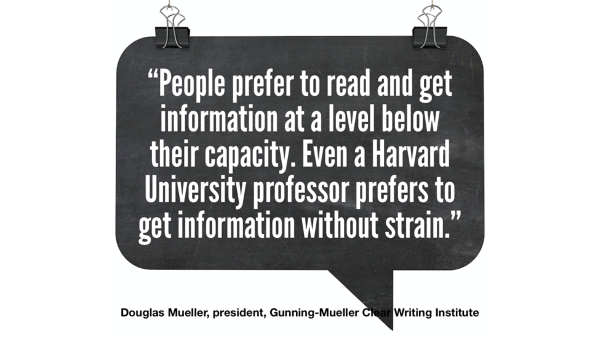Even rocket scientists and brain surgeons don’t want it to be harder
It never fails.

When I talk in my writing workshops about the importance of making copy easy to read and understand, there’s always one person who can’t believe the advice applies to her.
“Are you kidding?” she gasps. “I’m writing to executives/pharmacists/school district superintendents/telecomm engineers/financial planners/horse breeders. These folks are superbly educated, brilliant and divine. There’s no way they’ll read anything that easy.”
So you think your audience wants it to be harder? Think again.
1. Start with average.
The average U.S. adult reading level is 8th grade, research shows.
Is your audience average? Yes: Target 7th- or 8th-grade reading level.
Not so average?
2. Then consider going lower.
Some people are less literate than others. These demographics and preferences may affect your audience’s literacy levels, according to the world’s a huge global literacy test, the Program for the International Assessment of Adult Competencies:
Education. Education is the most reliable predictor of literacy, according to OECD. On average, literacy scores increase by 10 points for each year a person remains in school. The lower your readers’ level of education, the easier your copy should be to read.

Age. One-third of Americans age 65 or older fall into the lowest level of prose literacy. According to the PIAAC, reading and numbers skills:
- Increased from the teenage years through the mid 40s
- Plunged some 25 points between the 40 to 54 age group and the 55 to 64 age group
- Dropped 30 more points between the 55 to 64 age group and the oldest adults
In most countries, older people have lower literacy skills. That’s partly because seniors, on average, spent fewer years in school than young people.
Writing for readers 65 and older? Make your copy easier to read.
Industry. People with poor reading proficiency tend to have more health problems, for instance. So if you’re writing to health care consumers, consider aiming lower.
How low? The best reading level for health information is 5th grade, say researchers Michael D. Aldridge and Kenneth Brownson.
Place of birth. One-quarter of American immigrants have Level 1 — nonliterate — reading skills, according to the 1993. (And you should hear me try to say “Good morning” in Finnish.)
Economic level. More than four in 10 people with the lowest literacy rates on all three scales were impoverished.
Occupation. In general, the higher the literacy skills, the higher the job ranking, according to the 2003 PIAAC. Managers and professionals, for instance, tend to have higher literacy skills than technicians, craft workers or machine operators. And people with high literacy skills are less likely to be blue-collar workers than those with low skills.
Folks with Level 1 literacy on all three scales were far more likely to hold service jobs than people with Level 5 — college level — literacy, according to the 1993 PIAAC. The same thing is true of laborers, assemblers, fishermen or farmers.
Types of devices. Also, reduce the grade level when you’re writing for mobile devices. Mobile screens cut understanding in half, according to new research by R.I. Singh and colleagues from the University of Alberta.
3. Consider going higher.
But your audience members are rocket scientists or brain surgeons, right? They’ve had years of education.
Not surprisingly, people who had the highest literacy levels on all three scales were much more likely to hold managerial, professional or technical jobs than were respondents with the lowest literacy levels, according to NAAL. However, a few people with Level 1 and Level 2 literacy also held managerial, professional or technical positions.

In general, the higher the literacy skills, the higher the job ranking. Managers and professionals, for instance, tend to have higher literacy skills than technicians, craft workers or machine operators. And people with high literacy skills are less likely to be blue-collar workers than those with low skills.
While most managers and professionals have medium to high literacy skills — in the Netherlands, for example, 80% of managers and professionals have Level 3 literacy or above — not all do. In the Netherlands, 20% of managers and professionals have low levels of literacy. And in Chile, 60% or more managers and professionals have low literacy skills.
4. Consider going lower.
Some executives and entrepreneurs have attention deficit disorder (ADD).
Some people, apparently, turn their super-fast ADD brains into a professional asset.
“Hyperactivity can be transformed into hyperproductivity,” writes Julie Deardorff, a reporter at The Monterey County Herald. She quotes one executive who says that if he didn’t already have ADD, he’d find a way to get it.
Winston Churchill is believed to have had ADD. So, reportedly, do David Neeleman, founder of JetBlue Airways; Paul Orfalea, founder of Kinko’s; and Charles Schwab, founder and chairman of Charles Schwab & Co.
“I could manage — with effort — the little chunks of text you see in a memo or a newspaper. But a long book or a speech was almost impenetrable.”
— Charles Schwab, founder and chairman of the Charles Schwab Corporation
Schwab is also dyslexic.
“Some of the most accomplished CEOs have risen to the business world’s highest ranks despite having difficulty doing something as basic as reading a memo,” writes Mark C. Thompson in Chief Executive magazine.
What’s it like to be a dyslexic executive? According to Chief Executive:
“I could manage — with effort — the little chunks of text you see in a memo or a newspaper,” Schwab says. “But a long book or a speech was almost impenetrable.”
Let’s make sure “almost impenetrable” doesn’t apply to our executive communications.
5. Consider going lower.
Of course, your CEO doesn’t have to be dyslexic for the rules of clear, concise copy to make sense. Information overload can be disabling, too. And busy executives tend to suffer from it most.

I’ve always argued that if you think your audience members are especially elevated or educated, then you should make your copy more accessible.
Highly educated executives, after all, tend to have more stuff to read and less time to read it. So you’re obligated to make your messages for those folks even easier to process.
6. Consider going lower.
But even if you’re writing to brain surgeons and rocket scientists, keep your grade level average low. That’s because:
- People don’t read at their grade level. On average, high school graduates read at the 9th-grade level, according to William H. Dubay, readability consultant at Plain Language Services. College graduates at the 12th-grade level.
- Over time, reading skills decline. On average, Dubay says, adults read at five grade levels lower than the last grade they completed.
- Everyone benefits from readability. Highly literate people read a message 64% faster, understood it 13% better and enjoyed reading it 30% more when it was easier to read, according to a study by the Nielsen Norman Group.
- People don’t want to read at their grade level. That’s why The Wall Street Journal is written at the 11th-grade level. (The front page weighs in at 9th-grade.)
“People prefer to read and get information at a level below their capacity,” says Douglas Mueller, president of the Gunning-Mueller Clear Writing Institute. “Even a Harvard University professor prefers to get information without strain.”
Nobody wants it to be harder. No matter your audience, make your message easier to read.
___
Sources: Michael D. Aldridge, “Writing and Designing Readable Patient Education Materials,” Nephrology Nursing Journal, vol. 31, no. 4, July/August 2004, p. 373-377
Kenneth Brownson, “Literacy: A Problem that Managers Must Handle,” Hospital Materiel Management Quarterly, vol. 20, no. 1, August 1998, p. 37-47
William H. Dubay, “The Basics of Plain Language,” Impact Information: Plain Language Services, 2005
John Taylor Gatto, “The National Adult Literacy Survey,” The Odysseus Group
Douglas Mueller, “The Fog Index,” Folio:
Robert Longley, “U.S. High School Graduation Rate Hits All-time High,” About.com, July 5, 2004
TJ Larkin & Sandar Larkin, “Most Adults Can’t Understand Our Health Communication,” Larkin Page,No. 54, January 2007
TJ Larkin & Sandar Larkin, “Patients Don’t Remember Doctors’ Instructions,” Larkin Page, No. 78, January 2008
“The State of Literacy in America: Estimates at the Local, State and National Levels” (PDF), National Institute for Literacy, 1998
“What do low literacy and limited English proficiency mean?” U.S. Department of Transportation Federal Highway Administration, FHWA.dot.gov
Learn more:
- “Creative learning: How dyslexic CEOs have turned a weakness into a leadership strength” by Mark C. Thompson, Chief Executive, April 1, 2004
- “A few ADD sufferers see disorder as a gift” by Julie Deardorff, The Monterey County Herald, Nov. 26, 2005
- Delivered From Distraction by Edward Hallowell and John Ratey
- The Gift of ADHD by Lara Honos-Webb

Leave a Reply